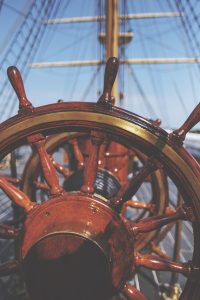There is no doubt that one of the most important parts of a sailboat is the sails.
In fact, you only have to look at the name of these boats to realize that sails are a main part of it.
Sailing trips would not be the same if the boat did not give so much importance to those parts of the boat and, we speak in the plural, since a sailboat has many different sails.
In this article you will learn how to differentiate the sails of a sailboat well and also know the parts of them.
To enjoy sailing much more and learn more about the sailboat you ride, we recommend that you pay attention to everything we have to show you.
Name of sails on a sailboat
Sails are probably one of the most important parts of the sailboat.
We are going to see in detail each of the most important sails that these boats have.
Mainsail
The mainsail is the one that stands out the most on a sailboat, as it is the largest sail.
This sail is very important as it is the wing responsible for providing momentum and steering control to the boat.
Depending on the needs of the navigation, the mainsail can be configured at three or four points.
In the case of a smaller sailboat, the mainsail is normally adjusted at three points to be able to adjust much better to the wind.
Jib
The jib is always located in the forestay and its main function is to balance the forces that are produced on the sailboat to improve its maneuverability.
This sail is perfect for supporting the mainsail and is located in the sailboat’s forestay, i.e. the line that holds the mainmast to the bow of the boat.
Genova
A triangular-shaped sail whose main purpose is to provide additional speed to the boat.
This sail is important when there are crosswind or favorable conditions and is used at the bow of the boat.
Spinaker
The Spinaker candle is characterized by its asymmetrical shape.
Esta vela es muy importante en las regatas and in high-performance sailing as it is able to provide an extra boost when the rest of the sails are not enough.
Thanks to the Spinaker sail, extra speed can be achieved when it is most difficult, making it especially useful in certain sports competitions. Spinaker’s sail is deployed at the stern of the ship.
Storm sail
As you can imagine from the name, these are sails that are deployed when the weather conditions are adverse.
Storm sails are used to improve the safety and control of the boat.
These sails are very robust so they withstand the most complicated weather conditions very well.
Bermuda Sailing
Bermuda sails are very popular in modern sailing.
These sails are triangular in shape and are very easy to manoeuvre, so they are often used on pleasure boats or family sailboats that do not require much experience to be crewed.
These sails have a variant known as the Gavia sail and is especially used on larger sailboats to increase the sail area.
Square candles
If you have seen old sailboats, you have surely seen that many of them have square sails.
These sails are no longer in use as they are less efficient than conical sails, however, they are very emblematic and it is easy to find them in the most classic boats due to the character they inspire.
Lateen
Latin candles stand out for their trapezoidal and asymmetrical shape.
These sails lean forward from the mast of the sailboat and stand out especially for their versatility to be able to take advantage of the wind.
This type of sail has been used a lot throughout history in boats that have Mediterranean traditions, for example, it was common to find them in the feluccas.
Crabclaw Sailing
This type of candle owes its name in English (crab) to its peculiar shape, as they look like the claws of a crab.
Thanks to their particular appearance, they adapt perfectly to specific wind conditions, so it is common to find them on the most traditional boats found in the Pacific islands.
Parts of a candle
The candles have three sides, the luff side, the baluma and the pujamen.
In addition to this, each of the corners of the candles, which are known as fists, have a different name depending on the position they occupy on the candle.
In this way there is the halyard grip, the sheet handle and the weapon grip.
In relation to the sides, the luff is the front of the boat’s sail.
This part is where the wind enters and through which the aerodynamic profile of the wind begins to form.
When we talk about the mainsail, the luff is the part that is attached to the neck.
In the case of jib, the luff is the part that is attached to the bow stay.
The baluma is the aft side of the sail.
This is the side where the wind goes and these sides are of great help for the correct trimming and also for shaping the sails.
On the other hand, the pujamen is the lower part or side of the candle.
It is located between the tack and the sheet handle and, in the case of the mainsail, it is located on the boom.
As for the sail grips, the tack grip is the lower front corner, the sheet grip is the lower vertex that is located most aft of the sail, and finally, the halyard grip is the one located at the upper vertex of the sail.
Types of boat sails
Finally, we can find different types of sails on boats depending on the material in which they are built.
The choice of one material or another is usually due to the different characteristics that are sought in each of the wings.
Canvas sails are mainly made of cotton or linen.
These are quite inexpensive candles and, in addition, they are durable and easy to repair.
The bad thing about these candles is that they are somewhat heavier than those made of synthetic materials because they also absorb much more moisture.
Polyester sails are made of synthetic fabric and are much lighter, but, on the other hand, they are also quite a bit more expensive.
These candles are very common today.
Another option is Dacron sails, similar to polyester, but with a higher resistance to breakage and tearing.
Kevlar is also another material that can be used, but it is quite expensive.
This material stands out especially for its resistance.
In the line of expensive sails, another very good option is Dyneema sails and also Mylar candles, which are especially used in spinnakers.
Finally, it is also worth highlighting the carbon sails that are quite typical in sailboats that compete in high-level regattas or luxury yachts due to the great aerodynamic performance they offer.
Depending on what we are looking for in the sailboat, one type of sail or others will be more interesting and it will also depend on what we want to spend on its purchase.










